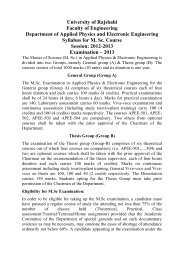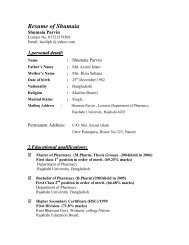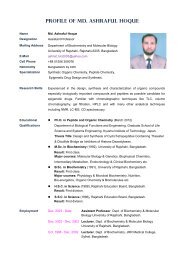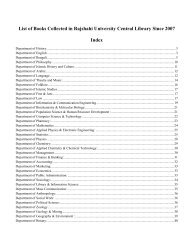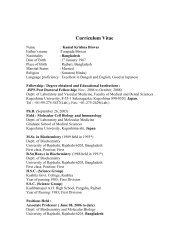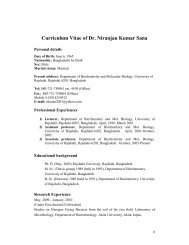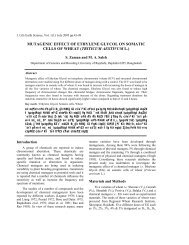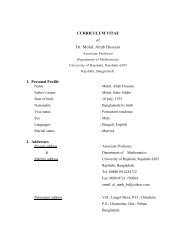University of Rajshahi
University of Rajshahi
University of Rajshahi
You also want an ePaper? Increase the reach of your titles
YUMPU automatically turns print PDFs into web optimized ePapers that Google loves.
<strong>University</strong> <strong>of</strong> <strong>Rajshahi</strong><br />
Syllabus for Postgraduate<br />
Program (2009-2010)<br />
IES Office<br />
4 th Science Building<br />
<strong>University</strong> <strong>of</strong> <strong>Rajshahi</strong>, <strong>Rajshahi</strong> 6205<br />
Telephone: +880 721 750930<br />
+880 721 750041 Ext 4166<br />
Fax :+880 721 750064<br />
Email: ies_ru_2004@lycos.com<br />
Website: www.iesru.edu.20m.com<br />
The <strong>University</strong> reserves the right to revise information, requirements, regulations, etc. at any time. Whenever changes occur,<br />
an effort will be made to notify those concerned.
POSTGRADUATE CURRICULA<br />
Postgraduate study in the Institute <strong>of</strong> Environmental science, <strong>University</strong> <strong>of</strong> <strong>Rajshahi</strong> will lead to M.Phil<br />
and PhD degrees. To obtain IES postgraduate degrees, in addition to completion <strong>of</strong> necessary coursework,<br />
students must prepare and successfully defend a thesis, which will investigate a problem that initiates,<br />
expands, strengthens or clarifies existing knowledge in the field. Students will be required to define an<br />
appropriate problem for investigation, review relevant information, develop a study plan incorporating<br />
techniques appropriate for the problem, implement the plan, and relate the results to already existing theory<br />
or a body <strong>of</strong> knowledge in the field. For a Doctor <strong>of</strong> Philosophy degree, however, students must make<br />
original contribution to their field <strong>of</strong> research.<br />
A recognized Masters degree (i.e., 3-year Bachelor plus 1-year Masters) or equivalent degree in any<br />
discipline related to environment is the normal entry requirement for the program. However, student from<br />
social science and business discipline background shall have a science background in higher<br />
secondary certificate level. Performances in the degree and/or relevant experience will also be considered<br />
in granting admission.<br />
Students seeking admission to postgraduate degree program are required to file their completed<br />
application forms which must include previous academic transcript, records <strong>of</strong> pr<strong>of</strong>essional qualifications if<br />
any, and a synopsis <strong>of</strong> their proposed research plan. Application forms for admission to the institute can be<br />
obtained directly from the IES Office.<br />
Successful applicants are normally registered for M.Phil in the first instance and those who wish to study<br />
for the Ph.D are transferred at a later stage (normally after one year) subject to satisfactory progress.<br />
Each student will be allotted a supervisor who has enough knowledge on the<br />
proposed research work to provide frequent personal supervision <strong>of</strong> the progress <strong>of</strong><br />
research and if necessary, co-supervisor(s) abiding by the principles <strong>of</strong> the<br />
<strong>University</strong> may be allotted.<br />
The academic programs at the Institute will be designed for people from a wide range <strong>of</strong> disciplinary<br />
backgrounds, pr<strong>of</strong>essional experience and environmental knowledge. It is envisaged that as well as<br />
environment, such backgrounds and experience may include physical science, life science, social science,<br />
economics, law, management and engineering, landscape architecture and the health pr<strong>of</strong>essions. The<br />
Institute aims at providing a flexible program, which can be tailored to individual student’s needs.<br />
The IES program will rest on a solid foundation <strong>of</strong> Core and Optional Courses, which will provide,<br />
respectively, both a basis <strong>of</strong> critical appreciation <strong>of</strong> frameworks <strong>of</strong> Environmental Science and basic<br />
‘environmental literacy’ in key disciplinary areas. Since students will bring very different knowledge bases<br />
to the program and may need to fill knowledge gaps, the latter courses will be seen as a key attribute in the<br />
environmental field, which necessarily involves collaborative as well as integrated decision-making by<br />
specialists from many disciplines. For this to be effective mutual understanding <strong>of</strong> others’ disciplinary<br />
perspectives is critical. Compulsory Courses will also provide for appreciation <strong>of</strong> the inherently inter-and<br />
trans-disciplinary nature <strong>of</strong> environmental science. Beyond this foundation, students, with the assistance <strong>of</strong><br />
the supervisors, will be free to design a balance program to suit their specific needs. This program will be<br />
taken from a wide range <strong>of</strong> Optional Courses, which will enhance their specialist expertise and will expand<br />
their knowledge and skills in the particular field related to their thesis research works.<br />
Students enrolled in the IES Postgraduate Program are required to complete a coursework made<br />
up <strong>of</strong>:<br />
<br />
Eight (8) Compulsory Courses <strong>of</strong> 24 credits<br />
Four (4) Optional Courses <strong>of</strong> 8 credits<br />
Course curricula and course description <strong>of</strong> Compulsory and Optional Courses for the IES Postgraduate<br />
Program follows:<br />
Page 2 <strong>of</strong> 12
Postgraduate Course Curricula (2009-2010)<br />
Compulsory Courses<br />
Number<br />
Title<br />
Total Hours <strong>of</strong><br />
Marks Lecture<br />
Credit<br />
ENV C701 Introduction to Environmental Science 75 42 3<br />
ENV C702 Ecology and Environment 75 42 3<br />
ENV C703 Environmental Pollution and Control 75 42 3<br />
ENV C704 Environmental Impact Assessment (EIA) 75 42 3<br />
ENV C705 Geo-Environment 75 42 3<br />
ENV C706 Research Methodology 75 42 3<br />
ENV C707 Disaster and Environmental Management 75 42 3<br />
ENV C708 Geo-informatics and Resource Mapping 75 42 3<br />
Total 8 (Eight) courses 600 336 24<br />
Number<br />
Four Optional Courses (200 marks 112hs. and 8 credits)<br />
Total<br />
Title<br />
Marks<br />
Hours <strong>of</strong><br />
Lecture<br />
ENV O751 Environmental Chemistry 50 28 2<br />
ENV O752 Environmental microbiology and Ecotoxicology 50 28 2<br />
ENV O753 Biodiversity 50 28 2<br />
ENV O754 Waste Management 50 28 2<br />
ENV O755 Water Resources: Planning and Management 50 28 2<br />
ENV O756 Climate Change and Global Warming 50 28 2<br />
ENV O757 Energy and Environment 50 28 2<br />
ENV O758 Environmental Health and Sanitation 50 28 2<br />
ENV O759 Wetland and Land degradation Management 50 28 2<br />
ENV O760 Environmental Policy and Modeling Design 50 28 2<br />
ENV O761<br />
Environmental Planning, Population and<br />
Sustainable Development<br />
50 28 2<br />
ENV O762 Environmental Law, Regulation and Human Rights 50 28 2<br />
ENV O763 Society and Environment 50 28 2<br />
ENV O764 Environmental Psychology 50 28 2<br />
Credit<br />
Page 3 <strong>of</strong> 12
POSTGRADUATE COURSE DESCRIPTIONS<br />
COMPULSORY COURSES<br />
ENV C701 Introduction to Environmental Science<br />
Definition, history <strong>of</strong> development <strong>of</strong> environmental science, field and their scope, significance,<br />
components <strong>of</strong> environment and their interactions; the general environment: radiation, heat, light, gravity,<br />
pressure, sound, physicochemal and phases, the atmospheric gases, dissolved salts as limiting factors,<br />
ecological relations <strong>of</strong> soil, abiotic and biotic factors in relation to individual; different kind <strong>of</strong><br />
environment, evolution <strong>of</strong> environment, ecological principle and their application, human influences on<br />
ecosystem, environmental ethics, religion and environment, interrelated nature <strong>of</strong> environmental problems,<br />
human impacts on natural environment, major environmental problems and issues.<br />
ENV C702 Ecology and Environment<br />
Ecology: autecology <strong>of</strong> species, population ecology, community ecology and ecosystem ecology; climatic,<br />
physiographic, edaphic and biotic factors. Productivity, food chain, food webs, trophic levels and<br />
ecological pyramids. Principles and concepts pertaining to biogeochemical cycles<br />
Habitat, ecological niche, ecological equivalents, sympatry and allopatry, natural selection, artificial<br />
selection. Fresh water, marine, estuarine, coastal, terrestrial and desert ecology.<br />
Limiting and regulating factors: Concept, Liebig’s Law, ecotypes, conditions, biological magnifications <strong>of</strong><br />
toxic substances, anthropogenic stress.<br />
Environmental monitoring: bio-monitoring, bio-indicator, stress, response, risk, sensitive indicators,<br />
cumulative indicators and eco-toxicology.<br />
ENV C703 Environmental Pollution and Control<br />
Water Pollution: classification <strong>of</strong> water pollutants, sources and consequences <strong>of</strong> water pollution and<br />
wastewater treatment techniques.<br />
Air pollution: sources and types <strong>of</strong> air pollutants, air quality standard, criteria and air pollution control.<br />
Noise sources. Noise pollution and abatement measures.<br />
Major soil contaminants and solid wastes – domestic waste, domestic solid waste, disposal <strong>of</strong> municipal<br />
and industrial waste; sludge treatment and disposal facilities; recovery <strong>of</strong> resources.<br />
Hazardous waste- Identification and characteristics <strong>of</strong> hazardous waste; processing and treatment <strong>of</strong><br />
hazardous waste. Radiation sources in the environment. Biological effects <strong>of</strong> radiation, dose limits.<br />
Technical controls for radioactive sources and radiation apparatus.<br />
Basic concept <strong>of</strong> chemical analysis: mole concept, analytical methods & techniques.<br />
ENV C704 Environmental Impact Assessment (EIA) and Environmental Management.<br />
Nexus between development and environment. Origin and development <strong>of</strong> EIA in USA and Bangladesh.<br />
Role <strong>of</strong> USEPA in developing the EIA in developing countries. Relation <strong>of</strong> EIA to sustainable<br />
development. EIA costing. EIA in project planning and implementation.<br />
Screening, Initial Environmental Examination (IEE) and detailed EIA. Categorization <strong>of</strong> projects and major<br />
criteria for project site location. EIA methodology: baseline information collection, scooping, impact<br />
assessment methods (checklist and matrix), mitigative measures, environmental management plan (EMP)<br />
and environmental monitoring. Application procedure for environmental clearance.<br />
Role <strong>of</strong> GIS in EIA baseline study. Risk assessment and risk management. Mitigation measures: Green<br />
bills. Review <strong>of</strong> EIA procedures in some developing countries: India, Srilanka, Thailand, Malaysia and<br />
Philippines.<br />
Page 4 <strong>of</strong> 12
ENV 705: Geo-Environment<br />
Geology and Environment, Importance <strong>of</strong> Geology in environmental science; Solar system; History <strong>of</strong><br />
Earth and Geological Time scale.<br />
Major Earth components:<br />
Atmosphere: Structure and composition <strong>of</strong> atmosphere; Significance <strong>of</strong> physical environment as a life<br />
support system; Incoming and outgoing radiation; Green house effect and Global warming.<br />
Lithosphere: Internal structure <strong>of</strong> the earth, composition <strong>of</strong> crust, mantle and core; Rock; Soil, soil<br />
classification, soil pr<strong>of</strong>ile and soil composition.<br />
Hydrosphere: World wide distribution <strong>of</strong> water, Surface water and ground Water, Vertical distribution <strong>of</strong><br />
groundwater, Hydrologic cycle, composition <strong>of</strong> ground Water, Principal chemical constituents in<br />
groundwater-Their sources, concentration and effect on usability; Aquifer and aquifer types; Sea water,<br />
composition <strong>of</strong> sea water, Sources <strong>of</strong> sea salt and salinity; Sea water intrusion and its Environmental Impact<br />
in coastal area <strong>of</strong> Bangladesh.<br />
Biosphere: Definition; Extent <strong>of</strong> biosphere etc.<br />
Geo- environment <strong>of</strong> Bangladesh: Area, population, physiography , hydrology, climate and vegetation;<br />
Geological characteristics <strong>of</strong> Bangladesh; Introduction to the Geo-environment <strong>of</strong> Indian subcontinent –<br />
physiographic division , mountains, glaciers and River basins-Ganges, Brahmaputra, Meghna and Indus.<br />
Biogenic deposits: Origin <strong>of</strong> petroleum; Natural gas, crude oil and coal,-their composition and<br />
classification ; Petroleum formation and reserve in Bangladesh; Impact <strong>of</strong> mining development on<br />
environment.<br />
Natural hazards: Floods, Soil erosion, Earthquakes, Volcanoes, cyclone and tornadoes, tidal surge,<br />
Tsunamis, Landslides – hazard characterization, extent <strong>of</strong> damage, prediction, control and management.<br />
ENV C706 Research Methodology<br />
Introduction to research; major components <strong>of</strong> research; field surveys; preparation <strong>of</strong> questionnaire;<br />
acquisition <strong>of</strong> data; sorting and handling primary and secondary data; statistical analysis <strong>of</strong> data;<br />
population; sampling methods; probability distribution: binomial, Poisson’s and normal distributions;<br />
statistical estimation; hypotheses; type I and type II errors; significance level; analysis <strong>of</strong> variance and<br />
covariance; parametric and non-parametric tests: z, t and F tests; chi-square, correlation test etc. regression<br />
analysis; multivariate analysis; ANOVA, ARMA analysis etc.<br />
Basic skills: basic computing, finding information, safety, ethics and other fundamental matters; project<br />
development: provides training and guidance in planning and managing research work; personal skills:<br />
skills in negotiations, team working, assertiveness and other transferable skills; proposal writing and<br />
research thesis writing; scientific article writing; journalistic essay writing etc.<br />
Data processing: Mathematical modeling s<strong>of</strong>tware and programm based studies on the environmental<br />
problems. Micros<strong>of</strong>t Excel, Graphical representation, Data Entry, Spreadsheet Analysis.<br />
Page 5 <strong>of</strong> 12
OPTIONAL COURSES<br />
(Any Four)<br />
ENV O751 Environmental Chemistry<br />
Chemistry <strong>of</strong> transition metals- definition, properties and their compounds. Chemistry <strong>of</strong> non-metals,<br />
definition, properties, and their compounds. Concept and scope <strong>of</strong> environmental chemistry; chemistry <strong>of</strong><br />
atmosphere, hydrosphere, biosphere and lithosphere; pollutants, contaminants and toxic substances in the<br />
environment and their fates; techniques to detect pollution in the environment; identification <strong>of</strong> sources <strong>of</strong><br />
pollution;<br />
Analytical techniques, Lambert Law, Beer Law, Optical method <strong>of</strong> analysis. Atomic absorption<br />
spectrophotometer. Electrical method, potentiometer. High Performance Liquid Chromatography (HPLC),<br />
Gas Chromatography (GC) Ion Chromatography (IC), etc.; statistical treatment <strong>of</strong> analytical measurement<br />
data; accuracy, reproducibility, significant value, inter-lab measurements, intra-lab measurements etc.<br />
ENV O752 Environmental Microbiology and Ecotoxicology<br />
Microbiology<br />
Introduction – definition, scope, classification <strong>of</strong> environmental microbes, the rhizosphere. R:S ratios,<br />
mycorhizae, root nodules, microbial plant, animal and human diseases with reference to sanitation:<br />
microbes and man – nature at functions <strong>of</strong> beneficial and pathogenic microbes: Environment and microbes<br />
– distribution pattern, types, composition, succession, productivity etc <strong>of</strong> microbial population in air, water<br />
and soil.<br />
Biogeochemical role <strong>of</strong> microorganisms – biogeochemical transformation <strong>of</strong> nitrogen, carbon, sulfur, and<br />
other nutrients, biodegradation <strong>of</strong> pollutants: Microbes in food – microorganisms in food, spoilage <strong>of</strong> food,<br />
microbial examination <strong>of</strong> food, control <strong>of</strong> microbes: Microbes in domestic and waste water – indicator<br />
organisms, coliform bacteria, bacteriological techniques in waste water treatment process.<br />
Microbial decomposition <strong>of</strong> chemically complex materials; use <strong>of</strong> bacteria and fungi to detoxify wastes,<br />
and conversion into usable substances. Prevention <strong>of</strong> biodeterioration <strong>of</strong> valuable materials, biodegradation<br />
<strong>of</strong> minerals, metals, cellulosics, aromatics, hydrocarbons, and wastewater treatment.<br />
Ecotoxicology<br />
Classification and sources <strong>of</strong> toxic substances. Pathways <strong>of</strong> toxic substances into ecosystem – principles<br />
and methods <strong>of</strong> studying toxins in an ecosystem. Effect <strong>of</strong> toxic substances – pesticides and therapeutic<br />
agents. Mutagenesis – distribution, biochemistry and abuse: Bioaccumulation, biomagnification and<br />
biomonitoring <strong>of</strong> toxic substances. Toxicological case studies in developed and under developed counties.<br />
Biochemical degradation <strong>of</strong> pollutants inside the cell: Cellular interaction with the pollutants: Pollutant<br />
interaction with biological system at different levels e.g., organisms, organs and tissues, cells. Active vs<br />
inactive processes: Enzymatic degradation by monoxygenesis: Role <strong>of</strong> cytochrome P450 and its multiple<br />
form: Metal toxicity; chemical form, metal biomacromolecule interaction, teratogenecity and<br />
carcinogenecity: Cellular/Tissue injury; altered membrane permeability, free radical formation, lipid<br />
peroxidation, lysosomal degradation, superoxide dismutase.<br />
ENV O753 Biodiversity<br />
Biodiversity: Concept, definition and different levels <strong>of</strong> biodiversity. biological, economical and social<br />
need for biodiversity, Species diversity and ecosystem stability. Biodiversity with respect to niche structure<br />
and tropic level. Assessment <strong>of</strong> biodiversity status and determination <strong>of</strong> IUCN threat categories. Sources <strong>of</strong><br />
genetic variation and biodiversity functions. Economical and social importance <strong>of</strong> biodiversity.<br />
Economical and social importance <strong>of</strong> biodiversity. Extinct, endangered, rare and vulnerable species.<br />
Biodiversity conservation methods: in-situ and ex-situ, gene bank, biotechnology, national park, zoo and<br />
herbarium. Eco-tourism and its benefit.<br />
Page 6 <strong>of</strong> 12
Different approaches <strong>of</strong> biodiversity conservation and management, registering biodiversity. Valuing<br />
biodiversity resources and their contribution to agriculture, community health and environment. Causes <strong>of</strong><br />
biodiversity loss. Techniques <strong>of</strong> species reintroduction and restoration <strong>of</strong> the degraded habitat.<br />
Biodiversity policy and legislation. Biodiversity and intellectual property right: Wildlife conservation and<br />
management: Status <strong>of</strong> biodiversity conservation in Bangladesh: Agenda 21 (Convention on biodiversity).<br />
ENV O754 Waste Management<br />
Solid waste - Sources and types <strong>of</strong> solid waste; physical and chemical properties <strong>of</strong> solid waste – domestic<br />
waste, domestic solid waste, disposal <strong>of</strong> municipal and industrial waste – different methods; sludge<br />
treatment and disposal facilities; recovery <strong>of</strong> resources.<br />
Hazardous waste- Identification and characteristics <strong>of</strong> hazardous waste; processing and treatment <strong>of</strong><br />
hazardous waste – physical processes, chemical processes, thermal processes biological processes; natural<br />
systems for hazardous waste treatment – waste stabilization pond, aquatic weeds and constructed wetland<br />
system; hazardous waste disposal, biological detoxification and application <strong>of</strong> biotechnology, institutional<br />
and legal framework.<br />
ENV O755 Water Resources: Planning and Management<br />
Environmental problems associated with groundwater in aquifer systems <strong>of</strong> importance to Bangladesh.<br />
Environments will include natural saline groundwater, deep sedimentary basins, groundwater-surface water<br />
interaction, fractured took, alluvial plain, and unconsolidated sediments.<br />
Principles <strong>of</strong> water quality control. Monitoring and sampling methods. Groundwater contamination<br />
evaluation. Site management and investigation. Risk assessment and risk management. Aquifer protection<br />
and rehabilitation. Remediation. Case studies.<br />
Basic concepts in the water resource planning and management: Precipitation, evaporation, transpiration,<br />
infiltration: Water resource development, and conservation in dry periods and in arid regions. Wetlands and<br />
water resources: soil-water relationship: Human impacts on water resources: Irrigation and flood control<br />
system. Participation <strong>of</strong> beneficiaries, formation <strong>of</strong> user’s group. Case studies <strong>of</strong> Farakka Barrage, the<br />
Flood Action Plan and the National Water Management Plan <strong>of</strong> Bangladesh.<br />
ENV O756 Climate Change and Global Warming<br />
Overview <strong>of</strong> climate system. Climate variation during the postglacial period and to assess prospects for<br />
future decades and, second, <strong>of</strong> current understanding <strong>of</strong> key climate issues such as the working <strong>of</strong> the<br />
climate system, impacts on humanity, the natural causes <strong>of</strong> climate change and anthropogenic effects on<br />
climate.<br />
Basic Science - Covers the fundamental science underlying the problem <strong>of</strong> global climate change induced<br />
by greenhouse and gas emissions, including greenhouse gas sources, gas cycles, modeling effects on global<br />
temperature, sea level and regional climate, detection <strong>of</strong> the global warming signal and climate impacts.<br />
Policy Responses - Adaptation and emission control, the two possible societal responses to the threat <strong>of</strong><br />
global climate change, and it involves the study <strong>of</strong> the practical application <strong>of</strong> policy-orientated models<br />
dealing with, for example, the imposition <strong>of</strong> emission targets, energy taxes and land management options as<br />
well as study <strong>of</strong> the Framework Convention on Climate Change.<br />
ENV O757 Energy and Environment<br />
Introduction – history and scope; importance: Energy use; world energy use, reserves. Energy demand and<br />
energy supply – approaches to energy balance, production and consumption <strong>of</strong> energy, transformation <strong>of</strong><br />
primary energy to secondary energy, final energy: Energy scenario in Bangladesh.<br />
Measurement <strong>of</strong> energy conservation – industrial, commercial, residential and transport sector; Thermal<br />
power plants energy conservation measures and pollution control hydroelectric power plants, potential<br />
impact on biodiversity and habitat loss: Nuclear power plant – disposal <strong>of</strong> radioactive waste.<br />
Renewable energy technologies: Solar energy, introduction to semiconductor p-n junction diodes,<br />
photoelectric effect, solar cell modules, application <strong>of</strong> solar cells, solar cells in rural electrification and<br />
other areas. Geothermal, wave, tidal and ocean energy importance <strong>of</strong> renewable energy in Bangladesh.<br />
Page 7 <strong>of</strong> 12
Biomass: introduction, biomass conservation, generation, biogas digester and design, operational problems<br />
and kinetic consideration <strong>of</strong> biogas digesters, introduction to pyrolysis and gasification. Wind energy; basic<br />
theory, types <strong>of</strong> turbines and their application. Clean Development Mechanism (CDM).<br />
ENV O758 Environmental Health and Sanitation<br />
Environment and diseases. Transmission <strong>of</strong> disease. Classification <strong>of</strong> transmission mechanisms (waterborne,<br />
water-washed, water based and insect vector). Classification <strong>of</strong> infections (excreta-related: faecaloral<br />
by bacteria and non-bacteria, soil transmitted helminthes, beef and pork tapeworms, water-based<br />
helminthes, excreta related insect vectors). Vectors, parasites and their control. Principles <strong>of</strong> toxicology.<br />
Epidemiological studies. Development <strong>of</strong> health criteria. Application to home, work and community<br />
environment. Comprehensive planning. Health administration.<br />
Environmental factors and quality <strong>of</strong> human health. Types <strong>of</strong> toxic substances affecting human health.<br />
Adverse effects <strong>of</strong> air pollution, water pollution and land degradation. Village, urban, industrial and<br />
institutional sanitation.<br />
Introduction to hygienic sanitation system. Water pollutants removal and purification techniques, water<br />
supply and different types sanitary toilets and waste management. Environmentally sound settlement<br />
planning.<br />
ENV O759 Wetland and Land Degradation Management<br />
Different types wetlands <strong>of</strong> Bangladesh and its area. Social, economical and biological importance <strong>of</strong><br />
wetlands. Causes for loss <strong>of</strong> wetlands. Conservation activities <strong>of</strong> wetlands through govt-NGO and local<br />
people’s participation.<br />
Physiographic and limnological characters <strong>of</strong> all types <strong>of</strong> wetlands. River, canal, ditch and lake water,<br />
nutrient cycles, eutrophicaion and its control, plankton and benthos <strong>of</strong> limnologic significance, distribution<br />
and role <strong>of</strong> aquatic plants in inland water. Wetland pollution and remedies in Bangladesh perspective.<br />
Major causes <strong>of</strong> land degradation in Bangladesh and in the world. Increased salinity and desertification<br />
problems.<br />
Inter-relationships <strong>of</strong> scientific, technical, cultural and social issues facing agriculture. Maintenance <strong>of</strong> soil<br />
fertility and techniques to control soil erosion. Principles <strong>of</strong> land use and environmental considerations.<br />
Agriculture and land use policy analysis. Case studies <strong>of</strong> the green revolution in developing nations<br />
together with their merits and demerits.<br />
ENV O760 Geographic Information System (GIS) and Remote Sensing<br />
Introduction - elements and principles. Data acquisition, storage, manipulation and interpretation.<br />
Importance <strong>of</strong> GIS in planning, management, monitoring and evaluation. Applications <strong>of</strong> GIS in resource<br />
management, monitoring, forecasting changes, service planning, transport network management, public<br />
protection and security services, mineral resource exploration and evaluation, watershed management,<br />
conservation and river basin planning. Hardware requirements. Use and application <strong>of</strong> GIS s<strong>of</strong>tware:<br />
ArcInfo, ArcView, ERDAS, IDRISI and ILWIS.<br />
Introduction - systems, techniques and commercial services. Primary data acquisition. Photogrammetry and<br />
remote sensing – advances in airborne and spaceborne sensor systems, digital photogrammetry, image<br />
understanding and computer-vision leading to integrated acquisition techniques. Concepts, systems and<br />
methods <strong>of</strong> image transformation and information extraction from primary data. Quality and performance<br />
<strong>of</strong> both topographic and thematic data processing. Interpretation and analysis <strong>of</strong> images. Optimization <strong>of</strong><br />
geoinformatics processes – planning and management <strong>of</strong> integrated geoinformation production systems.<br />
ENV O761 Environmental Planning, Population and Sustainable Development<br />
Significance <strong>of</strong> environmental planning and design in sustainable development. Planning processes and<br />
methodologies – content and function, the plan as a process, social and historical considerations, elements<br />
<strong>of</strong> planning and team work. Concept <strong>of</strong> planning in the developed and developing countries. Protection and<br />
restoration <strong>of</strong> natural system. Design plan – implementation process, comprehensive plan, zoning plan,<br />
industrial performance, history preservation, flexible zoning, specific plan.<br />
Page 8 <strong>of</strong> 12
Concepts <strong>of</strong> sustainable development, dynamic relationship <strong>of</strong> population, environment and sustainable<br />
development; methods <strong>of</strong> integrating population variables into development planning and institutional<br />
framework for formulating population and development planning.<br />
Ecological and other perspectives on the interrelationship <strong>of</strong> population and environment; consequences <strong>of</strong><br />
environment degradation; carrying capacity; utilization <strong>of</strong> resources; population-resource ratio; population<br />
and land utilization; population growth and increasing pressure on food and other resources; factors<br />
affecting supply and demand <strong>of</strong> natural resources, and environmental impact <strong>of</strong> development programs.<br />
ENV O762 Environmental Law, Regulation and Policy<br />
Basic concepts <strong>of</strong> policy, regulation and law; how a law is made, judicial systems; different types <strong>of</strong> law;<br />
history and relevance <strong>of</strong> environmental law; legal aspects <strong>of</strong> environmental resource management; origin <strong>of</strong><br />
environmental law in Bangladesh and other countries: major environmental laws, policies and regulations<br />
such as Environment Conservation Act (ECA, 1995), Environment Conservation Rules (ECR, 1997),<br />
Green Court (2000), Forest Ac (2000), Wildlife Preservation Act, Fish Ac etc. and some case studies;<br />
Roles <strong>of</strong> law enforcing authorities; contradictions in existing laws/policies <strong>of</strong> Bangladesh; strengths and<br />
weakness <strong>of</strong> different laws; ethics <strong>of</strong> resource management: obligation to future generation; the Lane<br />
Ethics: responsibilities <strong>of</strong> developed and developing nations;<br />
Environmental dispute and resolution over common resource sharing: river water sharing (Ganga, Nile,<br />
Indus, etc), trans-boundary air pollution, biological diversity & intellectual etc.; international<br />
environmental conventions, protocols and treaties and their implementation in Bangladesh; international<br />
organizations involved in environmental law, protocols, conventions and treaties (UNEP, UNDP, Green<br />
Peace, CBD, WWF, CITES, IUCN, etc<br />
Bangladesh Environment Policy, 1992. The Environmental Action Plan 1992. National agriculture policy,<br />
1999. Outline <strong>of</strong> the environmental issues <strong>of</strong> the agriculture sector. Bangladesh Fifth Year Plan (FFYP) in<br />
order to promote, nature, protect and expand nature and natural resources.<br />
ENV O763 Society and Environment<br />
Concept, nature and functions <strong>of</strong> society; social structure and social processes; social Institutions; approach<br />
to study social phenomena: Positivism and Humanism Different schools <strong>of</strong> thoughts and perspectives used<br />
in analysis and understanding social phenomena in social science; culture and social life; community life in<br />
rural and urban settings; influence <strong>of</strong> geographical heredity, Social and techniques factors and development<br />
on social life; interactions in human life: the Ecological Systems theory: The micro system, the more<br />
systems, the Exo system and the Macrosystem; the ecosystems model: Environmental –structural –culture –<br />
Family-etc.; intervention strategies with the people : Intervention with individuals, groups and<br />
communities- practicing social work for motivating and ensuing peoples participation in environmental<br />
issues and programs.<br />
Revisiting the concepts <strong>of</strong> Communication, Media, Environment and Awareness. Functions <strong>of</strong><br />
communication, and communication media. Importance <strong>of</strong> communication media in meeting environmental<br />
problems. Media theories and its critiques. Environmental psychology and the role <strong>of</strong> mass media in raising<br />
human awareness about environment. Researches on the role <strong>of</strong> communication media in raising people’s<br />
awareness and relevant learning.<br />
Environmental politics and International media. The role <strong>of</strong> the print, electronic, and folk media in<br />
Bangladesh to overcome environmental enigma and evaluation <strong>of</strong> the concerned media policies and related<br />
studies. Investigating the body <strong>of</strong> environment related indigenous knowledge in Bangladesh and the harms<br />
caused by mass media particularly in the sector <strong>of</strong> agriculture. Planning for communication campaign and<br />
advocacy for creating mass awareness for environment.<br />
Fundamentals <strong>of</strong> interrelation between environment policy-management issues and politico-administrative<br />
settings, socio-politico dynamics in the developing nations with special reference to Bangladesh.<br />
Environmental issues in the perception and papers <strong>of</strong> different stakeholders <strong>of</strong> the governance. Peoples<br />
participation in governance <strong>of</strong> environmental issues-experience <strong>of</strong> northern and southern countries. Go-<br />
NGO partnership in environmental management. Gender environment and governance.<br />
Page 9 <strong>of</strong> 12
ENV O764 Environmental Psychology<br />
The Environment: Current Events influencing environment, Methods used in environment psychology,<br />
environmental perception, cognition, attitudes.<br />
Effects <strong>of</strong> Environmental stresors: Environmental stress, temperature, humidity, sunshine, wind, Ion<br />
concentration, chemical pollution, noise, pollution density, urbanization, crowding, territoriality, privacy,<br />
personal space.<br />
Application <strong>of</strong> Environmental Psychology: Institutional design, residential design, environmental<br />
disaster, and technological catastrophe.<br />
Page 10 <strong>of</strong> 12
Recommended Reference:<br />
Anderson, R.M., Turnerand, R.D. and Taylor, L.R. 1994. Population Dynamics. Blackwell Pub.<br />
Arms, K. 1990. Environmental Science, London Sundars College Pub.,<br />
Ave`yj gv‡jK f~uBqv, 2003. cwi‡ek `~lY I wbqš¿Y, cÖ_g LÛ: evqy `~lY Ges wØZxq LÛ: cvwb<br />
`~lY| cÖKvkK, wg‡mm wbjydv †eMg, wm - 24, wmwWG, Avi/G G¨wiqv, c~e© bvwmivev`,<br />
†cvó e· bs: 4209, PUªMÖvg|<br />
Bala, B.K. 1997. Energy and Environment-Modeling and Simulation. NOVA Sci. Pub.<br />
Boaden, P.J.S. and Seed, R. 1985. An Introduction to Coastal Ecology. Blackie.<br />
Bouwer, H. Ground Water Hydrology.<br />
Brammer, H. 1996. The Geography <strong>of</strong> the soils <strong>of</strong> Bangladesh, <strong>University</strong> Press Ltd.<br />
Bridgan, H. 1990. Global Air Pollution. John Wiley and Sons.<br />
Browlow, H. Geochemistry.<br />
Burrus, L. and Spiegel, H. J. Earth in Crisis, 2 nd Edition.<br />
Byrne, K. Environmental Science, 2 nd Edition.<br />
Carlson, B: Psychology the Science <strong>of</strong> Behaviour; Allyn and Bacon.<br />
Chapman, J.L. and Reiss, M.J. 1997. Ecology: Principles and Application. Cambridge Univ. Press.<br />
Chhatwall G.R. 1993. Environmental Water Pollution and Control. Anmol. Pub., New Delhi.<br />
Chiras, D. Daniel. 1985. Environmental Science. A framework for Decision making. The Benjamin/Cummings Publishing Company,<br />
Inc California.<br />
Corson, W.H. The Global Ecology Handbook, Boston, Beacon Press.<br />
Cowon, J. Environmental Design.<br />
Dhaliwal, G.S. 2000. Fundamentals <strong>of</strong> Environmental Science, Kalyani Pub.,<br />
Elliot, R. 1995. Environmental Ethics. OUP.<br />
Emiliani, C. Planet Earth.<br />
Enger, E.D. and Smith B.F. 1995. Environmental Science: a study <strong>of</strong> interrelationship. WM C. Brown Pub.<br />
Fresland, P. 1997. Habitats and the Environment. Hodder and Stoughton. London.<br />
Gain, P. 2002. Bangladesh Environment-Facing the 21 st Century, SEHD, Bangladesh.<br />
Gaston, K.J. 1996. Biodiversity- a biology <strong>of</strong> numbers and difference, Blackwell Science.<br />
Gaston, K.J. and Spicer, J.I. 1998. Biodiversity an Introduction. Blackwell Science.<br />
Hannigan, J.A. 1995. Environmental Sociology. Routledge, London.<br />
Horne, A. Goldman, C. 1994. Limnology, GcGGraw Hill Inc.<br />
Horton, P.B. and Hant C.L. Sociology (5 th Edition), Mc-Graw Hill.<br />
Howard, D. and Remson, I. Geology in Environmental Planning.<br />
Howksworth, D.L. 1995. Biodiversity-Measurement and Estimation. Chapman and Hall.<br />
Jackson, A.K.W. and Jackson, J.M. 1996. Environmental Science, Longman.<br />
Keller, E.A. Environmental Geology, 4 th Edition.<br />
Khan, F.H. 1991. Geology <strong>of</strong> Bangladesh. Wiley Eastern, New Delhi.<br />
Krausk, K.B. and Bird, D.K. Introduction to Geochemistry.<br />
Krebs, C.J. 1994. Ecology. Benjamin Cumming.<br />
Krebs, C.J. 1995. Ecological Methods. Benjamin Cummings.<br />
Krishnan, M.S. 1982. Geology <strong>of</strong> India and Burma. CBS Pub. and and Distributors, India.<br />
Kudesia, V.P. Water Pollution, Meeraut, Pragati Prokashon.<br />
Leboyer, C.L. Psychology and Environment.<br />
Lehninger, A.L. Nelson, D.L. and Cox, M.M. 1993. Principles <strong>of</strong> Biochemistry. CBS Pub. and Distributors<br />
Manaham, E. Stanley. 1993. Fundamentals <strong>of</strong> Environmental Chemistry, LEWIS Publishers. New York.<br />
Page 11 <strong>of</strong> 12
Mishra S.R. 1996. Assessment <strong>of</strong> Water Pollution. APH Pub., New Delhi.<br />
Mishra, S.J. and Mani, D. 1994. Agriculture Pollution. Ashis Pub., New Delhi.<br />
Mukherjee, B. 1996. Environmental Biology, Tata McGraw-Hill Publishing Company Limited.<br />
Nath, B., Hens, L., Compton, P. and Devuyst. D. 1999. Environmental Management in Practice, Volume – 2, Routledge Butler and<br />
Tanner Limited London.<br />
Odum, E.P. 1996. Fundamental <strong>of</strong> Ecology, Nataraj Pub., Dehra Dun, India.<br />
Pickering, K.T. and Owen, L.A. 1997. An Introduction to Global Environmental Issues. Routledges.<br />
Rao, M.N. 1989. Air Pollution, Tata McGraw HillPub., Co., LTD.<br />
Richardson, DHS 1987. Biological Indicators <strong>of</strong> Pollution. Royal Iris Academy.<br />
Rose, J. 1998. Environmental Toxicology. Gordon and Beach.<br />
Russell, V. and Arrkkelin: Environmental Psychology, Prentice Hall, Englawood Cliffs, New Jersey.<br />
Sattar, S.A. Introduction to Environmental Laws <strong>of</strong> Bangladesh.<br />
Scott and Foresman. Earth Science.<br />
Sharma, P.D. 1995. Environmental Biology and Toxicology, Ann. Ar. bor. Sci. Pub.<br />
Sharma, P.D. 2000. Environmental Biology and Toxicology, MacMillan, India.<br />
Shukla, R.S. and Chandel, P.S. 2002. Plant Ecology and Soil Science. S. Chad and Company Limited, New Delhi.<br />
Sparks, D.L. 1995. Environmental Soil Chemistry. Academic Press.<br />
Tank, R. Focus as Environmental Geology.<br />
Thornbury W.D. 1969. Principal <strong>of</strong> Geomorphology. New Age Intern’s Ltd., India.<br />
Todd, D.K. 1989. Groundwater Hydrology. John Wiley and Sons.<br />
Tripathi, A.K. 1990. Water Pollution. Ashish Pub., New Delhi.<br />
Trivedi, R.N. 1997. A Text book <strong>of</strong> Environmental Science. Anmol Pub.,<br />
UNEP 1997. Handbook <strong>of</strong> Environmental Law. UNEP, Kenya.<br />
Warren, L.M. and Gibson, J. 1999. Environment Law and Policy. Blackwell Science.<br />
Wentz, C.A. 1989. Hazardous Waste Management. McGraw-Hill Book Co.,<br />
Wetzel, R.G. 1997. Limnology. WB Sounders.<br />
Whyte, R.O. 1980. Crop Production and Environment. Faber and Faber Ltd. London.<br />
Wild, L. 1996. Soils and the Environment. Cambridge Univ. Press.<br />
Wright, J. 2003. Environmental Chemistry, London.<br />
Page 12 <strong>of</strong> 12




